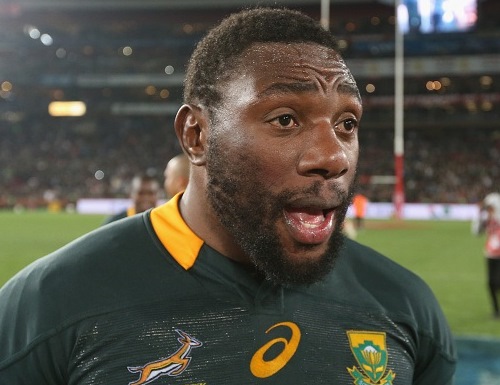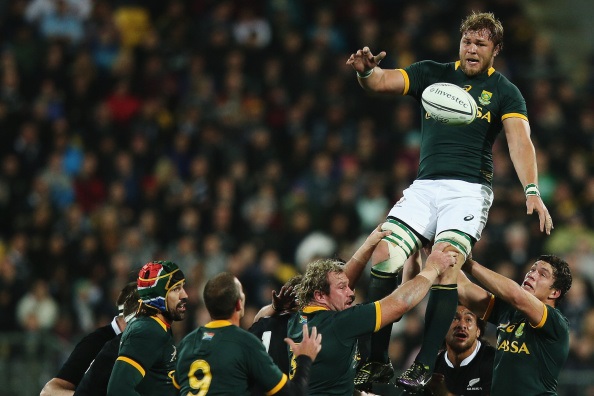
Tendai ‘Beast’ Mtawarira
South Africa finished second overall courtesy of their Ellis Park derring-do against New Zealand, and for but five points, the collective margin of defeat against the Wallabies in Perth and All Blacks in Wellington, it could have been a massive celebration for the team.
Admittedly the eventual champions boasted a 49-point difference advantage over the Springboks, but if the South African’s 4-2 ledger had been 5-1 (bonus points wouldn’t have come into the equation), the trophy would be theirs.
The victory is Meyer’s 24th in 33 Tests (a 73% winning mark), closes the gap in the IRB rankings (versus one and two) to just over two points, while the Republic boasts nearly a five point advantage over newly promoted England in third.
South Africa’s four wins and two losses equalled their return from last season, and their overall ten victories in The Rugby Championship’s history over 18 Tests gives them a three win lead over Australia (from 2012-2014) and second over the last three years (All Blacks 16-1-1).
sanzarrugby
Heyneke Meyer’s blood transfusion

Meyer’s insistence in playing a brand of rugby eerily similar to his Super Rugby championship winning Bulls wasn’t without reason, after all, the Springboks followed a similar style to win the 2007 Rugby World Cup and the 2009 Tri-Nations.
Yet some censors believed that the Springboks coach, despite proving himself, was being judged against his (now previous) inability to beat the All Blacks.
The conquest at Ellis Park verified that Meyer is willing to move away from a template that has been successful for him countless times.
The sight of the Springboks running and successfully bending and breaking the All Blacks defensive line has reconstructed how the South African public will expect the team to play in the future, but the tactical flow of the side is no longer flowing with blue blood.
Duane Vermeulen sums up his team’s approach

Much like All Blacks number eight Kieran Read redefined how his side played in 2013, the 1.94 metre, 118 (maybe 122 if reports of his strength gains are to be believed) was a scary sight that may even give New Zealand’s back row the Jeepers Creepers.
The two-time Currie Cup winner has quickly compiled 25 Tests since debuting in 2012, and the sight of the monstrous Nelspruit born back row forward cementing himself in numerous All Blacks rucks was a major factor.
While South Africa continues to ignore the services of a specialist open side or fetcher, to be fair it isn’t a role that appears necessary considering the heavy battleships Meyer is placing at the back of his pack.
All Blacks victory cannot hide flaws

A win against one of the better New Zealand Test teams in history is a massive jolt for the South Africans, but without sounding pessimistic and self depreciating, they didn’t win the title.
The loss against the Wallabies in Western Australia stung as if Rob Horne had been denied then the tourists would have claimed their fourth win in eight Tests in Perth.
Late finishing, a sizable element that enabled them to conquer the World Champions, wasn’t consistent throughout the tournament, while that uncanny sight of Los Pumas pushing the Springboks scrum back consistently was a negative for Meyer’s outfit.
Out wide the Springboks look a rejuvenated unit led by Handre Pollard, yet despite the awesome potency of the side at stages, they weren’t able to win convincing decisions against their rivals throughout The Rugby Championship up front.
Genuine win or illusion?

The All Blacks recent record gives them plenty of gratis, and while acclaims directed to South Africa are deserved, they are still distinctly second best when it comes to direct comparisons against their mighty rivals.
The Wallabies will know all too well the perils of celebrating success (be it a draw or win), based on the Eden Park reaction, while the Springboks know that they have put New Zealand on guard – the teams could clash in the 2015 Rugby World Cup semi-finals and the All Blacks might hold a grudge, as they did in 2011 against Australia.
Any success against the Kiwis, who have lost only 105 times since 1903, deserves a herald and poet, but Meyer will be wary of stating the balance of power has shifted.
Further changes?

Before 2014, any suggestions that Meyer would look beyond Morne Steyn as his first choice flyhalf would be considered heresy, but the double whammy of Pollard and Pat Lambie were immeasurable elements when considering the side’s recent revolution.
With the exception of a scrummaging lock and maybe a new technical presence in the front row, the Springboks won’t want to change much, although some veterans – think Matfield, de Villiers and the du Plessis brothers – could be dreadful losses for the South Africans without obvious backups.
The insertion of new talent, specifically in the backline, has boosted the world’s second ranked team, but while they appear to have options in the back row, the tight five might need evolve via the selection table in the next 12 months.